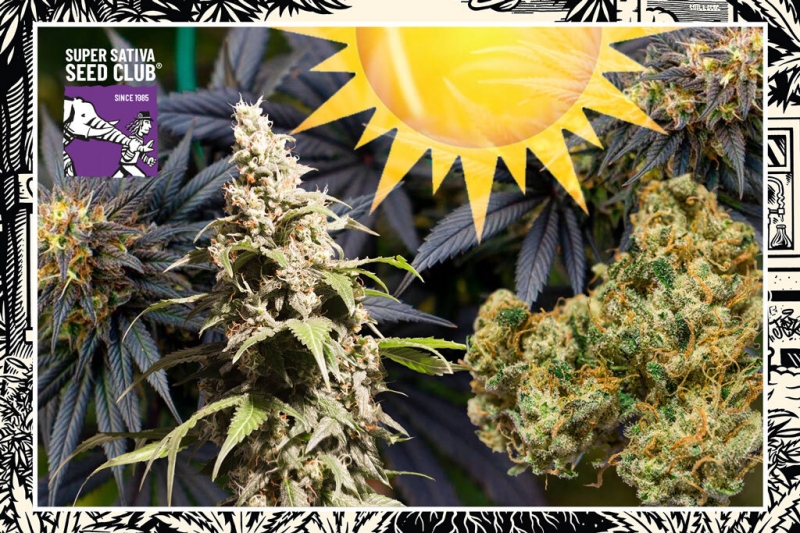
Hi, SSSC-Growers!
This weeks blog starts to explain the basics in our new series of articles on ‚How to grow the BEST buds‘.
FIRST BASIC TOPIC of OUTDOOR GROWING:
- choosing the right genetics for your local climate and environment
Every outdoor grower has to consider his local climate and environment in the preparations for another season of growing in nature. Here in Europe we have a moderate climate with four seasons (spring, summer, autumn and winter) and outdoor growing is limited to the period from beginning of May to middle of October. The rest of the year it is too cold and wet to grow cannabis plants outdoors. In more southern climates, which are warmer and have no seasons, you can grow cannabis all year round (e.g. in Hawaii).
Different species of cannabis have evolved in different climate zones and have specialized to thrive in the local climate. Pure Sativas have evolved in the humid and hot climate of India and have a very long flowering time since there are no seasons there, the hours of sunlight per day stay almost the same. Therefore the plant can grow very tall and flower for a longer time each season and produce more seeds this way. Sativas tend to grow taller with less dense and more fluffier buds, since this makes them less susceptible to mold in the humid climate they grow in.
Pure Indicas on the other hand have evolved in a high-altitude climate (e.g Pakistan) on dry soil with cold temps in the night and in winter. They stay shorter (=bushier growing-form) and have a shorter flowering time, since they have to be finished with growing their seeds before it gets too cold in autumn. Indicas tend to grow more compact and dense buds, since they are less prone to mold in the dry climate they originate from.
The third species of cannabis is called Ruderalis and has evolved in the northern cold plains of Kazakhstan, which have a very short summer and very long daylight hours (e.g 14-22 hours of light per day). Therefore Ruderalis plants grows very short and bushy and start to flower with maturity. That means after a while of growing a Ruderalis-plant automatically starts to flower and continues to grow and flower at the same time until she is finished, which is mostly 8 to 10 weeks after germination of the seed!
The easiest way to identify the main genetics of a living cannabis plant is via the fingers of the fan-leaves. Each cannabis leaf normally grows with an uneven amount of fingers (first with one, then with three, five, seven, nine, eleven, thirteen etc.) and the big fan-leaves normally have 7 or 9 fingers. The width of the individual fingers shows the main genetic traits, a Sativa plant has very thin (=narrow) fingered leaves, while an Indica plant has very thick (=broad) fingered leaves.
A Ruderalis plant can only be identified for sure, once she starts to flower under 18 to 24 hours of light per day, without the normal switch to 12/12 hours of light/darkness.
Nowadays most cannabis seeds that are sold commercially are some form of hybrid plants, that combine Sativa and Indica genes. You have indica-dominant hybrids (=bushier growing form and shorter flowering time, thick fingered leaves) and sativa dominant hybrids (=tall growing plants with a longer flowering time and thin fingered leaves). Professional seed producers like SSSC will have test grown their plants several times and in different conditions and therefore know the dominant genetic traits of a specific strain. This enables every grower to choose the correct seeds with a fitting flowering time and growing-pattern for his individual environmental situation.
For a successful outdoor grow in Europe you need a fast flowering variety (=flowering time of 8 to 9 weeks), which also finishes early enough before the wet and cold autumn weather arrives (=end of September to mid October). The strain should also be resistant to mold, since we have periods with strong rains during summer and sometimes cool and humid periods with fog in September.
A good example for seeds with these genetic traits is the Pineapple Poison from SSSC.
Since some European growers are faced with some challenges of legal nature, they prefer to grow very short plants, which are hard to detect (e.g. on a balcony), with a very short flowering period (=finished 9 to 10 weeks after germination), so those plants can be harvested as fast as possible. Those growers find the perfect solution in the so called AUTOMATIC or AUTOFLOWERING VARIETIES. Those seeds have some Ruderalis genes in them and therefore inherited the autoflowering trait. Nowadays autoflowering strains are just as good as photoperiod ones with large yields of excellent quality. They grow very short and are finished very quick, but still have decent yield of a good quality bud.
A good example for a high quality automatic variety are the seeds of Auto AK Triple Haze from SSSC.
Different growers have different desires about their harvest result and the effect the smoked bud has on them. Some are medical growers and need medicine against an ailment (e.g. a sedative strain (=mostly indica) against pain or for better sleep or an uplifting strain (=mostly sativa) against anxiety), which is free of contaminants (e.g pesticides, mold etc.) and harvests a big amount (e.g. most patients need bigger amounts than the usual cannabis smoker). Others are recreational growers and want a certain flavor or terpene-profile (e.g. a lemon flavor from the limonene terpene or a pine flavor from the pinene terpene) or desire an extra strong psychedelic effect (e.g. get very high or get very stoned).
All those different desires give certain requirements for the genetics of a strain and decide the choice of seeds the grower needs to grow to fulfill his desires.
We will go into more detail, which genetics have which effects, in our blog about the choice of genetics for the INDOOR GROW!
We hope you will continue to follow our new SSSC-series on ‚How to grow the BEST buds‘, so it will help you to get the MAXIMUM out of your SSSC-seeds. Next time we will make a little excursion into a funny story about what can go wrong when you choose the wrong genetics for outdoors.
(454) (0)


